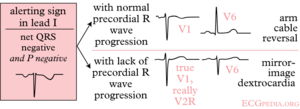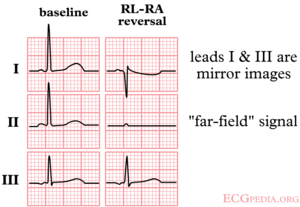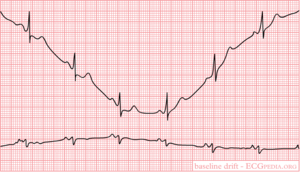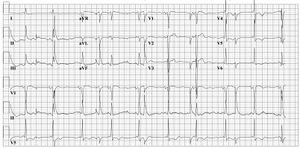Technical Problems: Difference between revisions
Jump to navigation
Jump to search
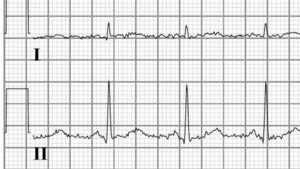
m (→Artefacts) |
|||
| Line 22: | Line 22: | ||
{{clr}} | {{clr}} | ||
== | ==Artefacts== | ||
[[Image:Noise_move.png|thumb| Movement artefacts]] | [[Image:Noise_move.png|thumb| Movement artefacts]] | ||
[[Image:ECG_Parkinson.png|thumb| Increasing movement artefacts in a Parkinson patient. The patient was in sinus rhythm! (which doesn't show on this short recording)]] | [[Image:ECG_Parkinson.png|thumb| Increasing movement artefacts in a Parkinson patient. The patient was in sinus rhythm! (which doesn't show on this short recording)]] | ||
Revision as of 19:07, 22 July 2007
Lead reversals
Sometimes an ECG is made properly. Mistakes do happen and leads can be switched. Always remain careful to check this or you might come to the wrong conclusions. One of the most common mistakes is to switch the right and left arm. This will result in negative complexes in I, indicating a right axis deviation!
Common mistakes are reversal of:
- right leg and right arm:
- Hardly any signal in lead II.
- right and left arm electrodes;
- reversal of leads II and III
- reversal of leads aVR and aVL
- left arm and left leg:
- reversal of leads I and II
- reversal od leads aVR and aVF
- inversion of lead III
- right arm and left leg:
- inversion of laeds I, II and III
- reversal of leads aVR and aVF
It is possible to distinguish lead reversal and dextrocardia by watching the precordial leads. Dextrocardia will show an R wave inversion, wheras lead reversal will not.
Artefacts

Electrical interference from a nearby electrical appliance. A typical example is a 100 Hz background distortion from fluorescent lights. Not to be confused with atrial fibrillation.
Artefacts (disturbances) can have many causes. Common causes are:
- Movement
- Electrical interference
